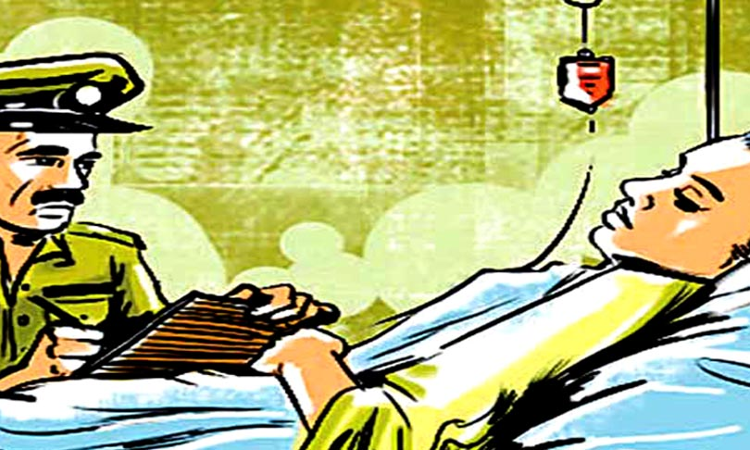The Law Of Dying Declarations In India: Bad In Law?
Ishaan Uday
5 March 2025 9:30 AM IST

A dying declaration is an oral or written statement by a person on the point of death concerning the cause of his death according to the Oxford English dictionary. Dying declarations have lost relevance and admissibility in many common law countries, all except India. The law concerning dying declarations in India could earlier be found in Section 32(1) of the Indian Evidence Act which reads, “When it relates to cause of death. - When the statement is made by a person as to the cause of his death, or as to any of the circumstances of the transaction which resulted in his death, in cases in which the cause of that person's death comes into question. Such statements are relevant whether the person who made them was or was not, at the time when they were made, under expectation of death, and whatever may be the nature of the proceeding in which the cause of his death comes into question.” After the passing of the criminal amendment bills by the Lok Sabha and their subsequent coming into effect in July 2024, the Indian Evidence Act has been replaced by the Bharatiya Sakshya Adhiniyam (BSA), 2023. Dying declarations outside of the purview of the Indian Legal system require a significant amount of corroboration for them to be admissible. However, that is not the case here as the Indian Judiciary has considered dying declarations to be of significant evidentiary value and upheld the maxim- "Nemo moriturus praesumitur mentiri” translating to 'A man will not meet his maker with a lie in his mouth.' The Indian Judiciary has time and again reiterated corroboration to be a rule of prudence and not a law of evidence with regards to such declarations differing from its English counterpart which requires strong corroboration and other witnesses. The Indian legal system however is satisfied with dying declarations being taken at face value. Dying declarations are admissible only when the person who has made the declaration in question is deceased and the cause of the person's death is called into question. The burden of proof falls on the prosecution and such declarations can also be used as sole evidence to convict and accused. The law states that a witness only becomes competent to be a witness and to testify in a Court of competent jurisdiction if they have seen or heard the facts in question, directly. However, this law is an exception to the rule of hearsay evidence as the cross examination and corroboration of the testimony is not a prerequisite.
History
The first dying declaration recorded was made as far back as 1202 in the case of Geoffrey v. Goddard with the reason for their admissibility being one of absolute necessity pointing to a possibility of a lack of other types of evidence. However it was only in the case of Woodcock Leach 500 and Thayer 355 was the abovementioned maxim of such a declaration was laid down. An excerpt from the judgement reads, “they are declarations made in extremity, when the party is at the point of death, and when every hope of this world is gone; when every motive to falsehood is silenced, and the mind is induced by the most powerful considerations to speak the truth; a situation so solemn and so awful, is considered by the law as creating an obligation equal to that which is imposed by a positive oath administered in a court of justice.” Thus the case of Woodcock reinforced the practice of 'irregular' or 'defective' depositions and dying declarations as an alternative to the already existing rule of depositions. However, the first time an alternative was suggested and placed in front of a Court to the deposition rule (which barred hearsay evidence) was in the case of King v. Radbourne. Even though the Court upheld the evidence here, it did not explicitly explain the reasoning behind its decision to do so. The criticism of dying declarations can be traced back to the nineteenth century particularly in a State Court case in the Supreme Court of Wisconsin in the United States where the defence questioned the credibility of such declarations and asking for it to not be regarded with much favour. The first codified law to recognise dying declarations a key evidentiary tool in India was the Indian Evidence Act of 1872.
How does the law in India differ from other common law systems?
Even though the Indian Evidence Act, 1872 was drafted under the advent of British rule, the Select Committee responsible for the drafting of the Act refused to use the phrase, 'hearsay evidence', calling it 'vague' and 'unsatisfactory', completely disregarding the universal legal concept of hearsay evidence and defying many tests set as precedents by various theories and legal systems giving rise to many differences in the fundamentals of this law setting the Indian legal system apart from the others. Originally under English Law, a dying declaration was only considered to be admissible when it was made with regards to a case having homicide or manslaughter as its subject matter while its Indian counterpart makes such a declaration admissible in all types of cases- civil or criminal. Another stark difference between the two is the admissibility of the declaration depending on the circumstances in which it was made. In English Law, a dying declaration is only good in law if it is made under the expectation of impending death. However, in the Indian context no such circumstances are taken into account and the declaration is admissible and good in law even if it is made when the declarant had no idea or any apprehension of his imminent death. Even though there are certain safeguards in place, they are more often 'preferred' and not mandatory according to the law laid down in several judgements of the Apex Court such as the one in the case of Khushal Rao v. State of Bombay. This case held corroboration not to be mandatory in cases of a 'true and voluntary' declaration. The ascertaining of a declaration being truthful and being given without any undue influence or compulsion is left to completely to the Judge(s). In Uka Ram v. State of Rajasthan it was held that a dying declaration need not have any corroboration attached to it if it creates 'confidence in the mind of the Court and is free from any form of tutoring.' A dying declaration recorded by a normal person (not a police officer or Magistrate) is also admissible if the person had made sure that the deceased was in a fit state of mind while making the statement in question, as was held in the case of Laxman v. State of Maharashtra (2002). The Apex Court has also ruled on the requirement of medical clearance by a Doctor certifying that the declarant was in a fit state of mind to give the declaration in the case of Poonam Bai v. State of Chattisgarh. It held that it was not necessary for a doctor to grant a medical certificate for fitness of mind of the declarant and a dying declaration cannot be solely invalidated on the grounds of not having clearance from a Doctor. It held certification by a Doctor to be a rule of prudence and therefore, not mandatory.
Shortcomings of the Indian Evidence Act in addressing the law regarding dying declarations
The Indian Evidence Act, 1872 has been replaced by the Bharatiya Sakshya Adhiniyam, 2023 after the passing of the criminal amendment bills in Parliament which forces one to believe that the rather outdated law concerning dying declarations in India must have been updated to be made more secure and reliable. Sadly that is not the case as the relevant section containing the same law under Section 26(a) of the BSA remains the same with no major amendments made. Section 26(a) reads, “when the statement is made by a person as to the cause of his death, or as to any of the circumstances of the transaction which resulted in his death, in cases in which the cause of that person's death comes into question. Such statements are relevant whether the person who made them was or was not, at the time when they were made, under expectation of death, and whatever may be the nature of the proceeding in which the cause of his death comes into question.” Apart from simplification of the language used, there is no significant change in the law, it still remains vague and leaves too much to judicial scrutiny. Laws which are broad and often ambiguous, leaving too much scope for judicial interpretation and scrutiny open windows to endless litigation and a plethora of conflicting judgements leading to more confusion and inconsistency in their application. There is also an increased chance of human error resulting in the passing of incorrect orders and an overall shambolic state of affairs leading to inefficiency, delays and at times even malpractice. In the push for a digital India and the legal system's push to be aided by technology to make the judicial process much quicker and efficient, we have seen the concept of E-FIRs under Section 173 of the Bharatiya Nyaya Suraksha Sanhita, 2023 (BNSS) be introduced for smoother filing of FIRs. However this 'push' seems to be inconsistent and is more of a gimmick than an actual step when one looks at how inconsistently it has been applied. Most common law countries have all in all shifted away from admitting dying declarations as an evidentiary tool due to the lack of credibility or have adopted modern methods of corroboration and audiovisual means to ensure reliability. Our lawmakers however have not correctly grasped the concept of decolonialisation. The lack of accountability that Section 32(1) of the Indian Evidence Act or Section 26 of the Bharatiya Sakshya Adhiniyam place in such a declaration is a continuation of the same error that the Select Committee made about a century and a half ago. The utter disregard of universal legal principles such as the rule of hearsay evidence has led to this gaping hole for abuse of this law due to lack of safeguards.
What does the current law lack and how can it be rectified?
Dying declarations without proper corroboration, backing up of the facts and circumstances by witnesses and recording of the statement by a proper authority should amount to mere hearsay. To ascribe to these declarations such high evidentiary value means relying too much on the principles of morality, both on part of the declarant and the Court. The very saying that a man will not meet his maker with a lie in his mouth is shrouded in age old moral principles and finds no legal ground to stand on. Morality is allowed to be subjective but the law must be clear and specific, especially one governing the rules of evidence. Section 26 of the BSA must be narrowed down to a large extent with specific guidelines on recording of the declarant's statement- 'Who can record the statement? How must it be recorded? How can the declarant's fitness be ascertained? What means must be employed to test the truthfulness of the statement?' A step in the right direction would be to encourage the use of audio visual means and subsequently make it a prerequisite in the recording of such statements (as this law is already an exception to the hearsay rule). A doctor's 'opinion' or medical clearance must be made mandatory to ensure and rule out the possibility of foul play. Furthermore, recording of such a statement by a normal person should certainly be corroborated with more evidence. One may argue that this should be left to the scrutiny of the Court but it is important to note that these declarations can very well lead to the conviction of the accused in any civil or criminal proceeding. The gravity of these declarations is tenfold and they enjoy unbridled evidentiary value. It is only correct for such a law to be specific and not to be left open for interpretation assessing the potential it has to abuse the power assigned to it. The current law is inexplicably outdated and lacks clarity. Specific guidelines governing the admissibility, recording and evidentiary value of dying declarations are quite clearly the need of the hour.
References
2. Khan, I., & Choudhary, H. (2022). Recording and admissibility of dying declaration. International Journal of Health Sciences, 6(S4), 7896–7903. https://doi.org/10.53730/ijhs.v6nS4.10319
3. https://blog.ipleaders.in/dying-declaration-2/
4. https://indiankanoon.org/research/topic/27973/
6. https://kjablr.kar.nic.in/assets/articles/Dying_Declaration_Its_applicability_in_Criminal_Cases.pdf
Views are personal.


